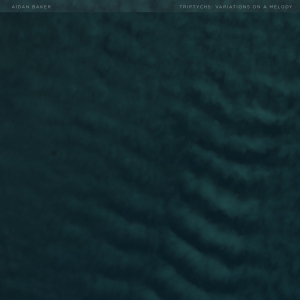 Aidan Baker is so prolific that his quality control might be open to question, except any criticism is disarmed by the near-impossibility of keeping pace with his myriad collaborations and solo projects. FortunatelyTriptychs would stand out in any discography. Inspired by Satie’s Gymnopédies and "furniture music" it is full of precise instrumentation which allows the music space to breathe and creates a serene, and meditative, air.
Aidan Baker is so prolific that his quality control might be open to question, except any criticism is disarmed by the near-impossibility of keeping pace with his myriad collaborations and solo projects. FortunatelyTriptychs would stand out in any discography. Inspired by Satie’s Gymnopédies and "furniture music" it is full of precise instrumentation which allows the music space to breathe and creates a serene, and meditative, air.
The concept is that a very simple and slow melody is repeated three times, with a harmonic line added for each repetition, resulting in a three part harmony. This progression makes for a simplicity and inevitability that are exquisite and comforting. Using a range of solo instruments provide variety and contrast.
The two versions of "Triptych One" feature Aidan Baker on electric and then acoustic 12-string guitars. From the off, delicate notes hang in the air, and a calm, deliberate, almost snail’s pace is set. Leah Buckareff’s electric bass on "Triptych Two" is a study in brooding isolation and David Nesselhauf’s double bass version even heavier and more doleful.
Baker returns on melodica for "Triptych Three" (throbbing and wheezing like a lonely, sleeping astronaut dreaming of an early morning cigarette). It is something of a masterstroke to match that with Katie English’s flute translation (as bright and fresh as a glistening row of icicles hanging from streetlights on a winter night.)
Four plaintive and mesmerizing versions of "Triptych Four" feature Rose Bolton and Peter Broderick on violins, Angela Chan on viola and Julia Kent on cello. Each of these maintain a mournful and serene mood. The album ends with three renditions of the poignant "Triptych Five" with Felicia Atkinson on organ, and then Broderick and Aki Yakamoto both shower piano notes, falling and rippling like raindrops landing on the middle of a wide placid lake.
Triptychs is dazzling, restrained, emotionally engaging, and ultimately so self-contained that attempts to describe it with subjective imagery merely approximate, or dilute, its power. At the same time, though, it is conducive to such intense flights of imagination. Each of these pieces are around three minutes long and all are wonderful. But heard from start to finish, the album reveals itself to be much more than the sum of its parts. If I could only give everyone one 2014 release, Triptychs is that gift.
 
Read More

